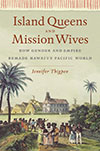book
Island Queens and Mission Wives: How Gender and Empire Remade Hawai‘i’s Pacific World
by Jennifer Thigpen :: University of North Carolina Press :: Reviewed by Hannelore Sudermann

When white missionaries landed on the sunlit shores of Hawai‘i in the early nineteenth century, they believed they were bringing God, culture, and civilization. They failed to realize that instead they were pulled into a sophisticated and long-standing system of Hawaiian diplomacy.
The missionaries’ relationship with the ruling families of Hawai‘i has long been the subject of study. But Thigpen, an associate professor of history at WSU, offers a different take. A specialist in nineteenth century U.S. history, women and gender, and colonialism, Thigpen explores the relationship of exchange between two cultures. She looks deeply into the interactions between the missionary wives and the ruling Hawaiian women and discovers that they set a foundation for alliances that would form Hawai‘i’s political future.
To the Hawaiians the shape of the relationship was obvious. It started with gift items exchanged between Hawaiian women and American missionaries and created a hierarchy based on obligation. Among other things, the ruling Hawaiians offered the newcomers fresh food, shelter, and permission to establish their missions. The missionaries mistook the gifts as tokens of gratitude for bringing their religion and culture to the islands. And they did not properly express their own appreciation for the Hawaiians’ generosity, crediting God instead.
By contrast, the Hawaiians saw themselves as “benefactors to a befuddled group of guests,” notes Thigpen. Eventually the missionaries would have to reciprocate. One opportunity to do so came when the ruling Hawaiians requested Western clothes. The missionary wives would visit the Hawaiians in their homes, measuring them and making clothes for them, creating a more intimate exchange than that of offering food and supplies.
Eventually the missionaries, both men and women, grew to understand that the Hawaiian women had a prominent role in their culture, more prominent than the Western women did in theirs, and that providing Western-style garments for the elite families was a step toward satisfying their obligations and key to supporting the interests of the mission.
The missionaries also came to see how central the relationships between the Hawaiian women and the missionary wives would be to bringing Christianity to the islands. They finally understood Hawai‘i’s culture of reciprocal obligation—even between classes. The high-ranking families provided the land and the commoners repaid that with labor.
While the Western perspective suggests that the missionaries strongly influenced the Hawaiians— from the Hawaiian perspective, they were just one group of many visitors from overseas with whom they had to establish a relationship. The Hawaiian’s long-standing diplomacy with missionaries and other visitors was central to, in Thigpen’s words, the “creation and evolution of a multiethnic, global community in the Pacific.”
Using the journals written by the missionaries themselves, resources from the Hawaiian Historical Society, and a number of books and scholarly works about the colonization of Hawai‘i, particularly those that looked at the history of the eighteenth and early nineteenth centuries from the Hawaiian’s perspective, Thigpen provides a deeper look into the early days of colonialism in Hawai‘i and a richer understanding of Hawaiian culture and diplomacy.